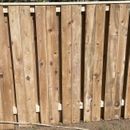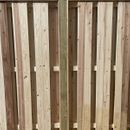Are these both cedar?
Hi,
I am trying to figure out whether these fence panels are both made from cedar. Does anyone know how to tell the difference?
The color, texture, density of these panels seem to be very different. I ordered the same material, but the smaller panels seem like they are quality cedar, the larger panels seem much more flimsy and doesn’t have the characteristic red color of cedar. The supplier only sells cedar, but I am wondering if they are giving me pine or something else instead.
GBA Detail Library
A collection of one thousand construction details organized by climate and house part











Replies
It's common for the quality of cedar (or wood generally) to vary between orders and milled batches. Based on your images alone it looks like it the larger boards could still be cedar. The surest test for me would be smell: with both western red and eastern white cedar the smell is very distinct and easy to identify. Cutting or even sanding a scrap or piece will release the perfume. The other possibility is that the second batch is an entirely different species of cedar.
In addition to different grades, there are a lot of different species of cedar, and several species in the cypress family are called cedar. At least one species in the juniper family is also called cedar. Your examples look like they could be in one of those groups, or they could be another conifer--what type of cedar were they sold as?
Thank you for your replies!
It does make me feel better that it looks like it could be cedar. They are just so different that it threw me off. And the large panels feel so much more flimsy that I felt very worried.
I do think both have the cedar scent. The panels are just advertised as “cedar fence panels”, and no specification as what type of cedar was given.
If it’s some sort of cedar, it’s probably very low quality. I should’ve been more careful while choosing the company I ordered from.
Thanks again for your help!
FenceproblemCin,
Unfortunately the quality of cedar has gone down precipitously in the last couple of decades. While harvesting old growth wood may be bad for the planet, it did yield much better lumber. The present day tree farms produce fast turnovers, which doesn't matter half as much for making sheet goods or framing lumber, but for the species used in fences or as siding, where the dense growth rings and greater presence of tannins is directly related to its longevity, the wood being sold today simply doesn't have the attributes we have traditionally associated it with. Although I live in an area with a plentiful supply, and many local sawmills, I hardly ever use cedar outside any more.
Hi Malcolm,
Would you say that for a general class of woods (e.g. softwood, medium, medium hard, hardwood etc) that tree age is relatively more important than species?
I have seen some places sourcing older trees (not necessarily old growth, but not nearly as young as most farmed trees) of possibly less desirable species from places like ecological restoration projects and I'm wondering if it might be worth tracking it down for siding and/or decking.
andyfrog,
I'm not sure I could make a blanket assertion that was true. Some species, like Western Hemlock or Spruce rot very quickly no matter how old they are. Is age enough to offset the natural characteristics of a wood? Maybe is some circumstances, but in general probably not.
Good to know, thanks. What about something like Western Juniper vs younger red 'cedar'?
Andyfrog,
It's something I just don't know enough about. Hopefully someone with a better understanding of their attributes will comment.
Different colors also come from different areas of the tree that the board is cut from. Heartwood nearer the center of the tree tends to be reader than the sapwood near the outer part of the tree. This is where those "two tone" boards get their coloration, they are cut in such a way that they have both heartwood and sapwood in the same plank. Wood is a natural product, so it's reasonable to expect a lot of variation from lot to lot and even board to board. Different growing conditions for the trees are also likely to affect the wood.
I came across an article that discusses some of the differences between different cedars here:
https://www.woodmagazine.com/materials-guide/lumber/sorting-cedar
Bill
This is easy, neither are cedar. A pet peeve of mine is the lumber industry's insistence on misnaming wood. And it's not like cedar is just the common name for the tree they're selling as cedar. Cedar is the common name for a genus of trees (cedrus), and none of the wood commercially sold as cedar is that. I don't know the history, but I strongly suspect this was initially an intentional deception, but now it's just grandfathered misinformation. The majority of commercial "cedar" in North America is either Thuja (called Western Red Cedar) or Juniper (called Eastern Red Cedar most often, though there's several others including aromatic cedar). Less common is another Thuja labelled as white cedar (variously eastern, atlantic or northern). A similar problem exists with poplar lumber, which is especially weird because there are tons of poplar trees around, but none of the poplar lumber is from those trees, it's from the tulip tree.
It's hard to definitively identify any wood by a picture, especially a low res picture of just long grain, but the second one is very consistent with most of the eastern red cedar I've seen. The one on the left is much less distinctive. It could be western red cedar, but could also be a bunch of other types. Both types of "cedar" are very light and soft, and they should have a distinctive odor that will be missing from more common softwood lumber. Western red cedar has an odour some associate with freshly sharpened pencil, eastern red is somewhat more citrus like.
Here's an interesting write-up on that subject.
https://www.thetreecenter.com/why-are-so-many-trees-called-cedar/
I'm not sure it's really the lumber industry per se, but lazy common naming perhaps.
I can really only speak from experience about white cedar (norther/eastern), but around here, that certainly is the common name, whether spotted in a lumber yard, in landscaping, or in the forest.
This is also an issue with 'sea bass', 'snapper', and 'scampi'